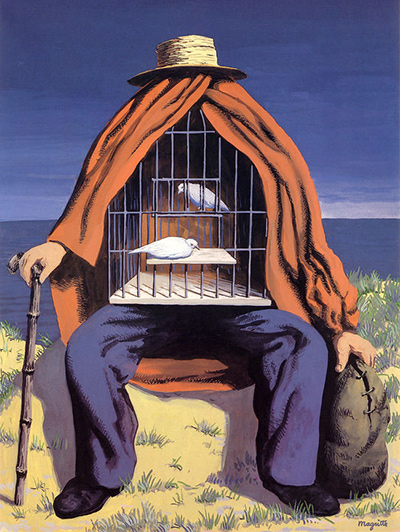One of the most celebrated Belgian artists of the twentieth century, Rene Magritte is a world renowned surrealist painter. His career in fine art began at the Académie des Beaux-Arts in Brussels, before he moved to Paris in the late 1920s and forged connections with other prominent surrealist painters such as Max Ernst and Salvador Dali.
Known for his idiosyncratic juxtapositions, and the air of mystery and psychoanalysis to his work, Magritte consistently challenges viewers to question their perception of reality.
The Therapist is a perfect example of the powerful paradoxes created by Magritte’s work, a piece that is both simplistic, and difficult to comprehend. Perhaps one of the best examples of the psychoanalysis influence to his work, The Therapist depicts a faceless person, wearing a hat and poncho, under which is an open cage and two birds – one on a ledge just outside the opening, and the other inside on a perch.
In the absence of a body and rib cage, it is the bird cage that gives the figure shape. We cannot be fully certain of the figure’s age and gender, though the presence of the walking stick and brown trousers and shoes lead to the assumption that it is an older male. The open cloak allows the viewer a glimpse into the figure’s soul.
It would not be unreasonable to expect that two caged birds would fly away at the first opportunity they had to escape. However, in true Magritte style and to question the ‘norm’, the birds are seemingly happy to forgo their freedom and remain where they are.
Maybe they are happy where they are, maybe they haven’t noticed, is the cage really open? Could the bird outside the cage be trying to convince the other to join it in a bid for freedom? Or it could be that the bird inside is calling the other back. Whatever Magritte’s reasoning behind The Therapist, there is no definitive answer, and it is left to the viewer to make their own assumption.




